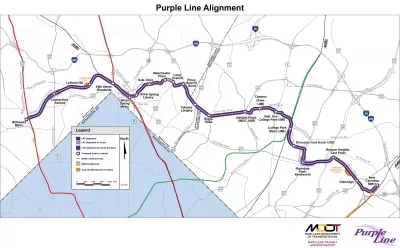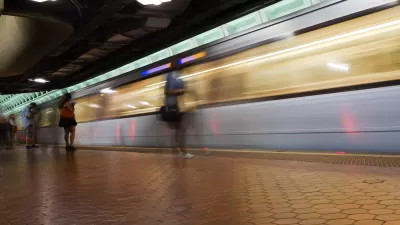The tool aims to help stakeholders "cut through regulatory complexity" and ensure equitable access to the light rail line's economic benefits.

A new tool from the University of Maryland’s National Center for Smart Growth Research and Education (NCSG) "provides easy access to a curated database of plans and regulations" in the Purple Line corridor, the area surrounding Maryland's upcoming Purple Line light rail. Cyrus Chimento, who worked on the project, writes in Greater Greater Washington that while the Purple Line project "presents massive benefits to locals such as increasing transportation access, decreasing pollution, and creating jobs," not all residents will share the benefits. "To combat this potential outcome, the Purple Line Corridor Coalition (PLCC) formed a community development agreement among businesses, nonprofits, government agencies, and community groups to make sure the Purple Line benefits are shared equitably among all residents and workers in the area." The coalition's goals include supporting and growing local businesses, improving access to housing choices, and building a thriving labor market.
The Plans and Regulations Information Tool aims to simplify the navigation of the area's complex regulatory environment. "The real power of the tool is to (very quickly) answer the general question underpinning those mentioned above: 'What plans or regulations apply to this place?' And since the Purple Line corridor spans multiple jurisdictions, we bring all the data together in one place." The tool is designed to assist developers and other interested stakeholders in understanding local regulations, and its designers hope "it can be a piece of the larger effort to make sure the benefits of the Purple Line investment accrue equitably."
FULL STORY: This tool helps create equitable development in communities surrounding the Purple Line

Study: Maui’s Plan to Convert Vacation Rentals to Long-Term Housing Could Cause Nearly $1 Billion Economic Loss
The plan would reduce visitor accommodation by 25,% resulting in 1,900 jobs lost.

Placekeeping: Setting a New Precedent for City Planners
How a preservation-based approach to redevelopment and urban design can prevent displacement and honor legacy communities.

Using Old Oil and Gas Wells for Green Energy Storage
Penn State researchers have found that repurposing abandoned oil and gas wells for geothermal-assisted compressed-air energy storage can boost efficiency, reduce environmental risks, and support clean energy and job transitions.

Washington State Plans Ambitious ‘Cycle Highway’ Network
The state is directing funding to close gaps in its existing bike network and make long-distance trips more accessible.

Homeowners Blame PG&E for Delays in ADU Permits
The utility says it has dramatically reduced its backlog, but applicants say they still face months-long delays for approvals for new electrical work.

Rethinking Wildfire Defense: How a Landscape Approach Can Protect Neighborhoods
Post-fire analysis of the Eaton Fire reveals that a landscape approach — including fire-resistant vegetation, home hardening, and strategic planning — can help reduce wildfire risk, challenging assumptions that trees and plants are primary fire hazards.
Urban Design for Planners 1: Software Tools
This six-course series explores essential urban design concepts using open source software and equips planners with the tools they need to participate fully in the urban design process.
Planning for Universal Design
Learn the tools for implementing Universal Design in planning regulations.
Borough of Carlisle
Caltrans
Heyer Gruel & Associates PA
Institute for Housing and Urban Development Studies (IHS)
City of Grandview
Harvard GSD Executive Education
Salt Lake City
NYU Wagner Graduate School of Public Service
City of Cambridge, Maryland





























